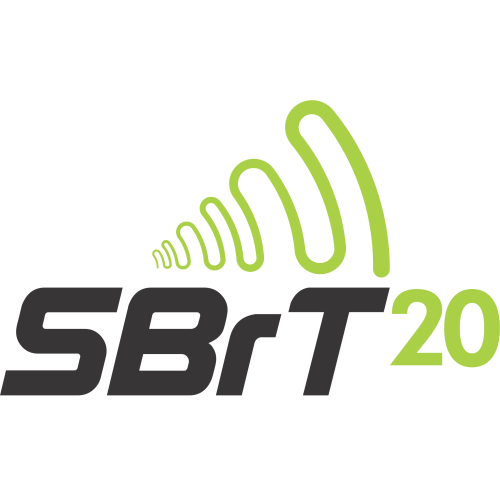
XXXVIII Simpósio Brasileiro de Telecomunicações e Processamento de Sinais
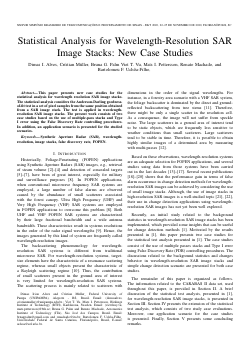
Statistical Analysis for Wavelength-Resolution SAR Image Stacks: New Case Studies
Dimas Irion Alves, Crístian Müller, Bruna G Palm, Vu Viet Thuy, Mats I. Pettersson, Renato Machado, Bartolomeu F. Uchôa-Filho
DOI: 10.14209/SBRT.2020.1570649631
Keywords: Synthetic Aperture Radar (SAR) Wavelengthresolution Image stacks False Discovery Rate
Abstract
This paper presents new case studies for the statistical analysis for wavelength resolution SAR image stacks. The statistical analysis considers the Anderson-Darling goodness-of-fit test in a set of pixel samples from the same position obtained from a SAR image stack. The test is applied in wavelength-resolution SAR image stacks. The present work consists of two case studies based on the use of multiple-pass stacks and Type I error using the False Discovery Rate controlling procedures. In addition, an application scenario is presented for the studied scenarios.Download
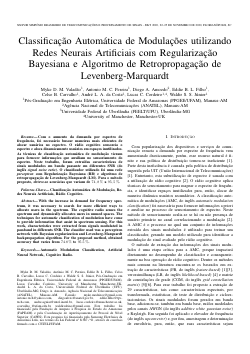
Classificação Automática de Modulações utilizando Redes Neurais Artificiais com regularização Bayesiana e algoritmo de retropropagação de Levenberg-Marquardt
Myke D. M. Valadão, Waldir Silva, André L. A. Costa, Celso Barbosa Carvalho, Diego A. Amoedo, Lucas Cordeiro, Eddie B de Lima Filho, Antonio M. C. Pereira
DOI: 10.14209/SBRT.2020.1570649633
Keywords: Classificação automática de modulações Redes neurais artificiais Rádio cognitivo
Abstract
With the increase in demand for frequency spectrum, it was necessary to search for more efficient ways to allocate users in the spectrum. The cognitive radio senses the spectrum and dynamically allocates users in unused spaces. The techniques for automatic classification of modulation have come to provide information that assist in spectrum sensing. For this work, characteristics were extracted from signals modulated in passband in differents SNR. The classifier used was a perceptron network with Bayesian regularization and Levenberg-Marquardt backpropagation algorithm. For the proposed method, obtained accuracy that varies from 74.8(%) to 95.5(%).Download
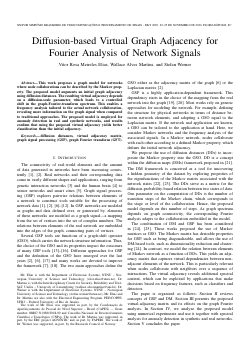
Diffusion-based Virtual Graph Adjacency for Fourier Analysis of Network Signals
Vitor R. M. Elias, Wallace A. Martins, Stefan Werner
DOI: 10.14209/SBRT.2020.1570649635
Keywords: diffusion distances virtual adjacency matrix graph signal processing (GSP) graph Fourier transform (GFT)
Abstract
This work proposes a graph model for networks where node collaborations can be described by the Markov property. The proposed model augments an initial graph adjacency using diffusion distances. The resulting virtual adjacency depends on a diffusion-scale parameter, which leads to a controlled shift in the graph-Fourier-transform spectrum. This enables a frequency analysis tailored to the actual network collaboration, revealing more information on the graph signal when compared to traditional approaches. The proposed model is employed for anomaly detection in real and synthetic networks, and results confirm that using the proposed virtual adjacency yields better classification than the initial adjacency.Download

Computer-Simulated UWB VHF SAR Targets Based on Statistics of Real Data
Bruna G Palm, Dimas Irion Alves, Renato Machado, Vu Viet Thuy, Mats I. Pettersson
DOI: 10.14209/SBRT.2020.1570649636
Keywords: CARABAS~II Computer-simulated targets SAR images Statistical analysis
Abstract
In this paper, we performed a statistical study of the targets of wavelength-resolution synthetic aperture radar (SAR) images and addressed the problem of limited training samples. Based on suitable statistical models for the real targets of the evaluated SAR image, we considered a sample generator method to create computer-simulated targets. For such, well-known statistical models, namely, Burr, Gamma, Gaussian, Log-normal, Rayleigh, Rician, and Weibull, are considered for the Anderson-Darling (AD) goodness-of-fit test. This test is a statistical nonparametric hypothesis test generally used to investigate whether a given probability distribution yields a good fit for a given data set. The images used in this study were obtained from the Swedish ultrawideband (UWB) very-high-frequency (VHF) SAR CARABAS II system whose consists of 24 magnitude single-look SAR images. The obtained computer-simulated targets followed similar statistical characteristics when compared to the real ones.Download
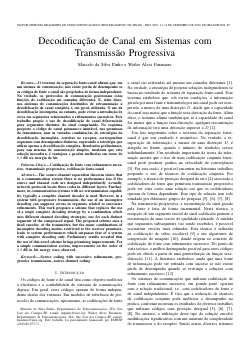
Decodificação de Canal em Sistemas com Transmissão Progressiva
Marcelo S. Pinho, Weiler A. Finamore
DOI: 10.14209/SBRT.2020.1570649640
Keywords: codificação de fonte com refinamento sucessivo transmissão progressiva codificação fonte-canal
Abstract
The source-channel separation theorem states that in a communication system there is no performance loss if the source and channel code are designed independently. Actually, network protocols locate these codes in different layers. Furthermore, in communication systems with no retransmission capability, typically a complete channel decoder is used. However, in a system with progressive transmission, the use of an incomplete decoding can suppress errors in segments related to successive refinements. This work proposes a scheme that replaces the use of a single complete decoding strategy by a combination which uses different channel decoding strategies, one for each distinct segments of the compressed signal. The proposed scheme uses a fixed encoder, at the transmitter, but the many combinations of incomplete decoding modes, restricted to the receiver premisses, leads to system performances which surpasses that of a system with complete decoding only. Preliminary results revealed that the use of this novel scheme brings promising improvements. For a simple communication system, improvements on the order of 0.2 dB in bit energy were observed.Download
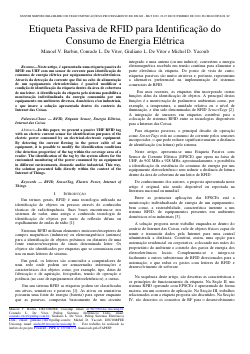
Etiqueta Passiva de RFID para Identificação do Consumo de Energia Elétrica
Manoel V. Barbin, Michel Daoud Yacoub, Conrado De Vitor, Giuliano De Vitor
DOI: 10.14209/SBRT.2020.1570649644
Keywords: RFID SensorTag Electric Power Internet of Things
Abstract
In this paper, we present a passive UHF RFID tag with an electric current sensor for identification purposes of the electric power consumed by an electrical-electronic equipment. By detecting the current flowing in the power cable of an equipment, it is possible to modify the identification conditions (the detection properties) of the tag within the coverage area of a reader. The identification of the tag by the system allows for the customized monitoring of the power consumed by an equipment in different environments, domestic and/or industrial. This way, the solution presented falls directly within the context of the Internet of Things.Download
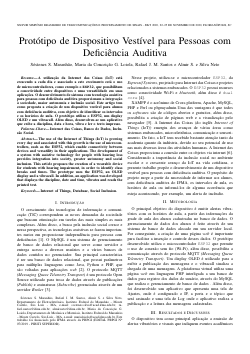
Protótipo de Dispositivo Vestível para Pessoas com Deficiência Auditiva
Almir Neto, Rafael M Santos, Sóstenes S Maranhão, Maria Loiola
DOI: 10.14209/SBRT.2020.1570649647
Keywords: Internet das Coisas Banco de Dados Inclusão Social
Abstract
A utilização da Internet das Coisas (IoT) está crescendo a cada dia e um dos fatores é a utilização de microcontroladores, como exemplo o ESP32, que possibilitam a conectividade entre dispositivos e uma versatilidade em suas aplicações. Este artigo tem como proposta a criação de um dispositivo vestível para pessoas com deficiência auditiva (DISPAUDI), com objetivo de identificar os intervalos e os horários de aula, proporcionando a inclusão social escolar. Além disso, o protótipo realiza o gerenciamento de dados e comunicação via web.Download
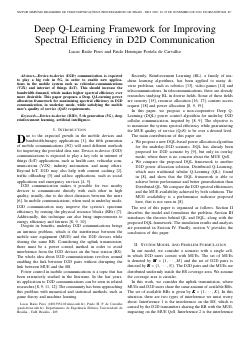
Deep Q-Learning Framework for Improving Spectral Efficiency in D2D Communication
Lucas Baião Pires, Paulo Henrique Portela de Carvalho
DOI: 10.14209/SBRT.2020.1570649648
Keywords: Device-to-device (D2D) 5-th generation (5G) deep reinforcement learning artificial intelligence
Abstract
Device-to-device (D2D) communication is expected to play a big role in 5G, in order to enable new applications in the mobile system such as vehicular-communications (V2X) and internet of things (IoT). This should increase the bandwidth demand, which makes higher spectral efficiency ever more desirable. This paper proposes a Deep Q-Learning power allocation framework for maximizing spectral efficiency in D2D communication, in underlay mode, while satisfying the mobile user's quality of service (QoS) requirements.Download
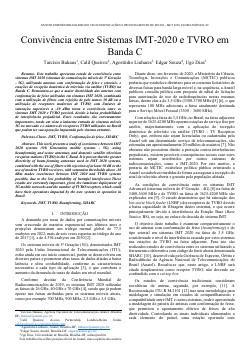
Convivência entre Sistemas IMT-2020 e TVRO em Banda C
Tarcisio Bakaus, Calil Queiroz, Agostinho Linhares, Edgar Souza, Ugo Dias
DOI: 10.14209/SBRT.2020.1570649652
Keywords: IMT TVRO Beamforming SHARC
Abstract
This work presents a study of coexistence between IMT 2020 systems (5th Generation mobile systems - 5G), using beamforming and sector antennas, and domestic satellite television reception stations (TVRO) in the C Band. It is proven that the greater directivity of beam-forming antennas used in IMT 2020 systems, combined with the use of filters with rejection of at least 30 dB or the use of modern TVRO receivers, with saturation thresholds above -30 dBm makes coexistence between IMT 2020 and TVRO systems possible, due to the low probability of harmful interference.These results are extremely important, given the imminent deployment of 5G mobile networks and the number of TVRO receptors, which could have their operations impacted by the new systems in operation in Brazil.Download

Difusão Periódica Multinomial Ótima em VANETs Slotted Aloha Multicanal com Restrição Temporal
Geovanny Lucas de Lima Paulino, João P. J. V. da Silva, Renato M. de Moraes
DOI: 10.14209/SBRT.2020.1570649658
Keywords: Redes Ad Hoc Slotted Aloha VANETs
Abstract
This paper describes a periodic rebroadcasting protocol for safety (warning) messages delivery in vehicular ad hoc networks (VANETs), following a multinomial probabilistic distribution modeling to calculate the successful delivery probability. The method uses Slotted Aloha as medium access control (MAC) protocol employing multiple communication channels. A mathematical model of the multinomial approach is conceived, and also simulation is performed to validate the model and generate results. This approach achieves successful delivery probability of 99,9%, in a time deadline of 100 ms, attending the safety requirements for VANETs, and outperforms the previous related proposed approaches.Download